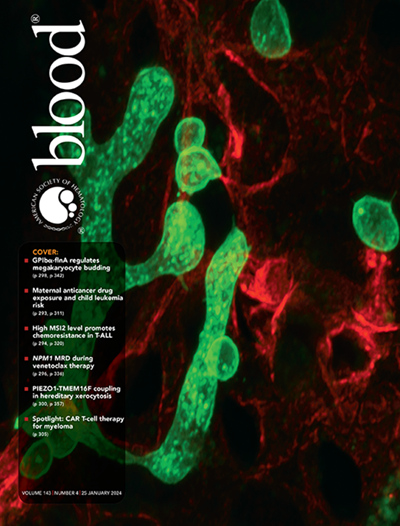The acute myeloid leukemia microenvironment impairs neutrophil maturation and function through NFκB signaling.
IF 21
1区 医学
Q1 HEMATOLOGY
引用次数: 0
Abstract
Acute myeloid leukemia (AML), an aggressive hematological malignancy, is driven by oncogenic mutations in stem and progenitor cells that give rise to AML blasts. While these mutations are well-characterized, their impact on healthy hematopoiesis-those blood cells exposed to AML but not mutated-has not been well-characterized. As the marrow is the major site for granulopoiesis, neutrophils are heavily influenced by AML pathobiology. Indeed, most AML patients report neutropenia, rendering them susceptible to infections. However, since AML studies use peripheral blood mononuclear cells devoid of neutrophils, the characterization of neutrophil dysfunction remains poorly understood. To investigate AML-exposed neutrophils, a pre-clinical AML mouse model was used where primary leukemic cells were transplanted into non-irradiated neutrophil reporter (Ly6G-tdTomato; Catchup) hosts. Neutrophils could not completely mature, suggesting impaired granulopoiesis. Single-cell transcriptomics of AML-exposed neutrophils revealed higher inflammation signatures and expression of CD14, an inflammatory marker. To address the factors contributing to this biology, an ex vivo cytokine screen was performed on marrow neutrophils and identified that NFκB signaling drove CD14 expression. AML-exposed neutrophils displayed widespread chromatin remodeling, and de novo motif discovery predicted increased binding sites for CCAAT-enhancer-binding proteins (C/EBPs) and Interferon regulatory factors (IRFs). Moreover, AML-exposed neutrophils inhibited T-cell proliferation, highlighting their immune-suppressive capability. Finally, similar biology of immature, inflammatory neutrophils was found in AML patients, again indicating dysregulated granulopoiesis. Collectively, these data show that AML-associated inflammation alters neutrophil granulopoiesis, impairs neutrophil function, and drives immunosuppression, thus contributing to patient susceptibility to infection.急性髓性白血病微环境通过nf - κ b信号通路影响中性粒细胞成熟和功能。
急性髓性白血病(AML)是一种侵袭性血液系统恶性肿瘤,是由干细胞和祖细胞中的致癌突变驱动的,这些突变会产生AML原细胞。虽然这些突变有很好的特征,但它们对健康造血(那些暴露于AML但未突变的血细胞)的影响还没有很好的特征。由于骨髓是粒细胞生成的主要部位,中性粒细胞受到AML病理生物学的严重影响。事实上,大多数AML患者报告中性粒细胞减少,使他们易受感染。然而,由于AML研究使用缺乏中性粒细胞的外周血单个核细胞,中性粒细胞功能障碍的表征仍然知之甚少。为了研究AML暴露的中性粒细胞,使用临床前AML小鼠模型,将原代白血病细胞移植到未辐照的中性粒细胞报告细胞(Ly6G-tdTomato;调味酱)主机。中性粒细胞不能完全成熟,提示颗粒生成功能受损。aml暴露的中性粒细胞的单细胞转录组学显示出更高的炎症特征和CD14(炎症标志物)的表达。为了解决促成这种生物学的因素,对骨髓中性粒细胞进行了体外细胞因子筛选,并确定NFκB信号驱动CD14表达。aml暴露的中性粒细胞表现出广泛的染色质重塑,新基序发现预测ccaat增强子结合蛋白(C/ ebp)和干扰素调节因子(irf)的结合位点增加。此外,aml暴露的中性粒细胞抑制t细胞增殖,突出了它们的免疫抑制能力。最后,在AML患者中发现了类似的未成熟炎症中性粒细胞生物学,再次表明颗粒生成失调。总的来说,这些数据表明aml相关炎症改变中性粒细胞生成,损害中性粒细胞功能,并驱动免疫抑制,从而导致患者对感染的易感性。
本文章由计算机程序翻译,如有差异,请以英文原文为准。
求助全文
约1分钟内获得全文
求助全文
来源期刊

Blood
医学-血液学
CiteScore
23.60
自引率
3.90%
发文量
955
审稿时长
1 months
期刊介绍:
Blood, the official journal of the American Society of Hematology, published online and in print, provides an international forum for the publication of original articles describing basic laboratory, translational, and clinical investigations in hematology. Primary research articles will be published under the following scientific categories: Clinical Trials and Observations; Gene Therapy; Hematopoiesis and Stem Cells; Immunobiology and Immunotherapy scope; Myeloid Neoplasia; Lymphoid Neoplasia; Phagocytes, Granulocytes and Myelopoiesis; Platelets and Thrombopoiesis; Red Cells, Iron and Erythropoiesis; Thrombosis and Hemostasis; Transfusion Medicine; Transplantation; and Vascular Biology. Papers can be listed under more than one category as appropriate.
 求助内容:
求助内容: 应助结果提醒方式:
应助结果提醒方式:


